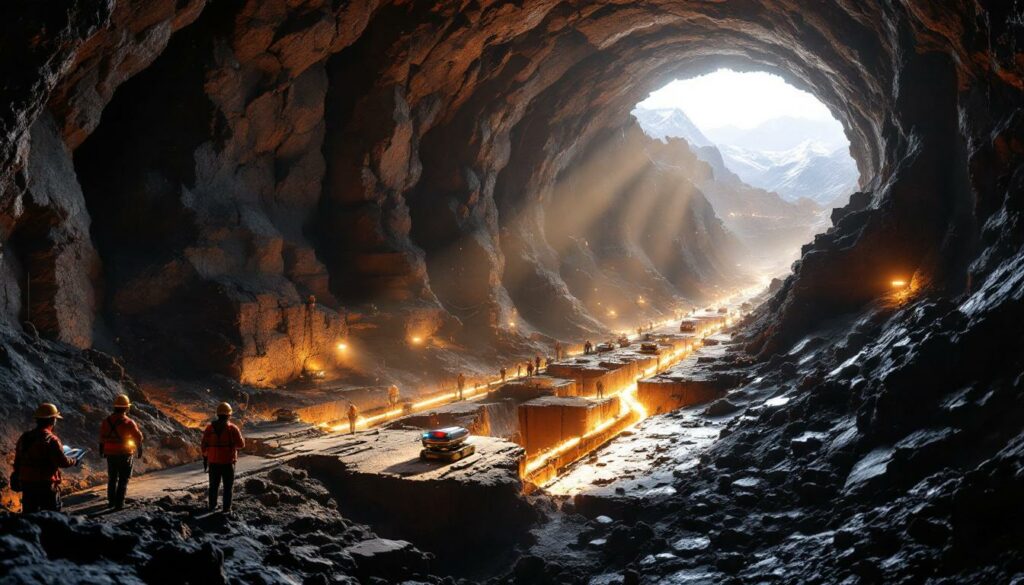The El Teniente Mine Rescue: Understanding Chile's Latest Mining Emergency
The world holds its breath as rescue operations unfold at Chile's El Teniente copper mine, where a powerful seismic event has trapped miners deep underground. This latest incident adds to Chile's history of mining emergencies, though rescue teams are working tirelessly to reach those trapped beneath the Andes mountains. The rescue of trapped miners in Chile represents a critical test of emergency protocols and mining mental health strategies that have evolved significantly over the past decade.
What Happened at El Teniente Copper Mine?
The Triggering Event and Immediate Impact
A 4.2-magnitude tremor struck Chile's El Teniente copper mine on Thursday, causing significant tunnel collapses throughout the world's largest underground copper complex. The powerful seismic event resulted in one fatality, nine injuries, and left five workers trapped underground with no established communication.
El Teniente General Manager Andrés Music described the tremor as "one of the largest events — if not the largest — that the El Teniente mine has experienced in decades" (ABC News, August 1, 2025). The severity of the event immediately prompted Codelco, Chile's state-owned mining company, to mobilize rescue operations.
The Current Status of Trapped Miners
As of Friday, the five miners have been without contact for approximately 18 hours. This communication blackout adds significant complexity to the rescue effort, as teams cannot assess the miners' conditions or precise location.
"The tunnels are closed, they've collapsed. There's no possibility of even radio communication," Music explained to reporters (ABC News, August 1, 2025). This complete communication breakdown distinguishes this incident from some previous mining emergencies where limited contact remained possible.
The rescue teams face a race against time, working with the understanding that establishing contact is the critical first step in what could be a complex extraction operation.
Why is the El Teniente Mine Significant?
World's Largest Underground Copper Operation
El Teniente holds the distinction of being the world's largest underground copper deposit. The complex spans more than 4,500 kilometers of tunnels and underground galleries carved into the Andes mountains. This vast network, while impressive from an engineering standpoint, makes rescue operations particularly challenging.
The scale of El Teniente is difficult to comprehend – if laid end-to-end, its tunnels would stretch from New York to Los Angeles. For rescue teams, this means navigating an immense labyrinth while dealing with unstable conditions and the threat of aftershocks.
Economic Importance to Chile
El Teniente represents a crucial component of Chile's copper industry, which forms the backbone of the nation's economy. Copper has been called "Chile's salary" for its central role in the country's economic well-being, with mining accounting for approximately 10-15% of the nation's GDP.
While copper extraction operations have been temporarily halted, union leader Amador Pantoja noted that other facilities continue functioning: "The plant and the smelter are operating normally, as we always have a supply of both ore and concentrate. It's the mine that is currently shut down" (ABC News, August 1, 2025).
This partial operational capacity helps minimize immediate economic impacts, though extended disruption could affect Chile's export revenues and potentially global copper market trends.
How Are Rescue Efforts Progressing?
Current Rescue Strategy and Timeline
Codelco's rescue teams have established a 12-hour window during which they hope aftershocks will subside enough to deploy remotely operated equipment. These sophisticated machines, similar to robots or drones, will help workers clear debris blocking access to the trapped miners.
Nearly 100 personnel have been mobilized for the operation, working in shifts to maintain continuous progress. The team includes mining engineers, geologists, medical personnel, and specialized rescue experts with experience in previous mining emergencies.
Music has indicated that reaching the trapped workers within the next 12 hours is their primary goal. This timeline suggests rescue coordinators believe there are viable access routes, though significant clearing work will be required.
Challenges Facing Rescue Teams
Several factors complicate the rescue operation:
- Continuing aftershocks making tunnel access dangerous for rescue personnel
- Complete communication blackout with trapped workers, preventing location confirmation
- Extensive tunnel collapses blocking multiple potential access routes
- The mine's complex network spanning thousands of kilometers, creating navigation challenges
- Uncertainty about air quality and structural stability in affected areas
The remotely operated equipment represents a technological solution to some of these challenges, allowing assessment of dangerous areas without risking additional human lives.
What Safety Measures Were in Place?
Mining Safety Protocols in High-Risk Environments
Modern underground mining operations typically incorporate multiple safety systems, including seismic monitoring networks, emergency refuge chambers, and communication redundancies. While specific details about El Teniente's safety infrastructure haven't been released, Chilean mines generally maintain advanced safety protocols due to the country's seismic activity.
Standard equipment for miners in such environments includes self-contained self-rescuers (breathing apparatus), communication devices, and emergency provisions. However, the severity of tunnel collapses may have compromised some of these systems.
Investigation into Causes
Codelco has launched an investigation to determine whether the tremor resulted from natural seismic activity—common in earthquake-prone Chile—or was triggered by mining operations themselves. This distinction is crucial for both the current rescue and future safety planning.
Music specifically noted that "neither explosives nor drilling had caused the accident" (ABC News, August 1, 2025), suggesting the event may have been purely geological in nature. Chile's location along the Pacific "Ring of Fire" makes it particularly susceptible to earthquakes, which can trigger secondary events in mining regions.
How Does This Compare to Previous Mining Incidents?
Historical Context of Mining Accidents in Chile
Chile's mining industry has experienced several significant emergencies over the decades, reflecting both the geological challenges of the region and the inherent risks of underground extraction. These incidents have shaped rescue protocols and safety regulations throughout the country.
The most internationally recognized incident occurred in 2010 at the San José copper-gold mine near Copiapó, where 33 miners were trapped for an extraordinary 69 days before being successfully rescued. That operation captured global attention and demonstrated both the challenges and possibilities of deep mining rescues, as documented in the detailed timeline of the Chilean miners' ordeal.
While the current El Teniente situation involves fewer trapped miners, the complete communication blackout and extensive tunnel collapses present unique challenges that differ from the Copiapó incident.
Lessons Applied from Past Rescues
Chilean mining authorities have continuously refined their emergency response capabilities following each incident. Improvements typically include:
- Advanced drilling and tunnel-boring technologies capable of creating rescue shafts
- Better coordination between government agencies, mining companies, and international experts
- Enhanced medical support protocols for extended underground survival
- More sophisticated communication systems and backup options
- Psychological support strategies for both trapped miners and their families
The current rescue operation likely incorporates many of these lessons, though the specific circumstances of each mining emergency require tailored approaches, reflecting ongoing industry evolution insights.
What is the Projected Timeline for the Rescue?
Critical Window for Rescue Operations
Codelco officials have emphasized that the next 48 hours are critical for the rescue operation. This window reflects both the urgency of reaching potentially injured miners and the expected pattern of aftershocks, which typically diminish in frequency and intensity after the initial event.
The immediate goal is establishing contact with the trapped miners within 12 hours, as stated by Music. Once contact is established, rescue teams can assess the miners' condition, provide initial supplies if possible, and develop a comprehensive extraction plan based on actual conditions.
"Every minute counts in these situations. Our primary focus is establishing communication, then ensuring life-sustaining conditions, and finally executing a safe extraction," Music emphasized to reporters (ABC News, August 1, 2025).
Technological Solutions Being Deployed
The planned use of remotely operated equipment represents a sophisticated technological approach to the rescue. These devices can:
- Navigate through spaces too narrow or dangerous for human rescuers
- Capture high-definition video to assess tunnel conditions and structural integrity
- In some cases, deliver small supplies like water, food, or communication devices
- Map potential rescue routes while monitoring air quality and other environmental factors
This technology-first approach demonstrates how mining rescue operations have evolved, incorporating robotics and remote sensing to enhance safety and efficiency as part of modern mine planning frameworks.
What Impact Will This Have on Copper Production?
Operational Adjustments at El Teniente
While copper extraction has been temporarily halted, processing facilities continue to operate using existing ore and concentrate supplies. This arrangement allows Codelco to maintain some production capacity while focusing resources on the rescue effort.
The Andesita project, one of Codelco's newest development initiatives at El Teniente that was due to begin production in Q2 2025, may face delays depending on the extent of damage and subsequent safety reviews.
Union leader Pantoja's statement about continued processing operations indicates the company is implementing standard contingency plans that allow for temporary mining interruptions without completely halting production.
Market Implications
The incident has already affected Codelco's business operations, with the company postponing the release of its second-quarter financial results that were originally scheduled for Friday. This postponement reflects both the operational disruption and the need to assess potential financial impacts.
Chile produces approximately 28% of the world's copper, making any significant disruption potentially impactful for global markets. However, analysts suggest that unless the mine closure extends for weeks or months, global copper supplies are unlikely to face major constraints from this single incident.
For investors and commodity markets, the situation bears monitoring but doesn't yet represent a supply crisis that would dramatically affect pricing.
How Are Families of Trapped Miners Being Supported?
Communication and Support Services
During mining emergencies, companies typically establish family support centers where relatives can receive regular updates, psychological support, and other assistance. These centers provide crucial information conduits and emotional support during the uncertainty of rescue operations.
Standard protocols in Chilean mining emergencies include:
- Regular briefings from rescue coordinators and company officials
- Access to medical and psychological professionals
- Private areas for families to gather away from media attention
- Assistance with practical needs such as transportation and accommodations
- Religious or spiritual support as requested
While specific details about family support in this case haven't been released, such services are standard practice during mining rescues in Chile, reflecting lessons learned from previous incidents.
Community Response
Mining communities in Chile often rally around affected families during emergencies, providing both emotional and practical support. The tight-knit nature of mining towns creates strong community bonds that become particularly important during crises.
This community resilience was demonstrated dramatically during the 2010 Copiapó rescue, when the "Camp Hope" community of families maintained a 69-day vigil at the mine entrance. While the current situation at El Teniente differs in scale, similar community support networks typically activate quickly in mining regions.
FAQ: El Teniente Mine Rescue Operation
Where exactly is the El Teniente mine located?
The El Teniente copper mine is located in central Chile, nestled in the Andes mountains approximately 80 kilometers south of Santiago, Chile's capital city. Its high-altitude position contributes to both operational challenges and the complex geology of the region.
How deep are the trapped miners?
While the exact depth hasn't been specified in current reports, El Teniente's operations extend hundreds of meters below the surface, with some tunnels reaching depths of over 1,000 meters. The vertical dimension adds significant complexity to rescue operations, as teams must account for air pressure differences and extended travel times.
What safety equipment do miners typically carry?
Underground miners at large operations like El Teniente typically carry:
- Self-contained self-rescuers (emergency breathing apparatus)
- Personal communication devices
- LED headlamps with backup power
- Basic first aid supplies
- Location identifiers or tracking systems
- Emergency ration packs in some areas
However, the severity of the tunnel collapses may have compromised some of this equipment, particularly communication devices.
How long can miners survive if trapped?
Survival duration depends on multiple factors including air quality, temperature, access to water, injuries, and psychological state. With proper air circulation and water, miners can potentially survive for weeks, as demonstrated in previous incidents.
Key survival factors include:
- Availability of breathable air (oxygen levels and absence of toxic gases)
- Access to drinking water (moisture from rock walls can sometimes be collected)
- Temperature regulation (mines maintain relatively constant temperatures, though humidity can cause complications)
- Treatment of any injuries
- Psychological resilience and group dynamics
The 2010 Copiapó incident demonstrated extraordinary survival capacity, with miners rationing emergency food supplies and organizing themselves into a functioning micro-society during their 69-day ordeal.
What is Codelco's safety record?
Codelco, as Chile's state-owned mining company, maintains extensive safety protocols, though like all mining operations, it has experienced accidents throughout its history. The company operates some of the world's largest copper mines and has invested significantly in safety technology and training.
Mining safety in Chile has improved substantially in recent decades, with fatality rates declining through regulatory improvements, technology adoption, and enhanced training. However, the inherent risks of underground mining in seismically active regions remain a constant challenge for operators.
This incident will likely prompt a comprehensive review of safety measures at El Teniente, potentially leading to enhanced seismic monitoring systems and emergency response protocols, including better mine reclamation innovations.
Further Exploration
The rescue of trapped miners in Chile continues to develop as an urgent humanitarian mission. For those interested in learning more about mining rescues and the challenges they present, numerous resources are available through mining safety organizations, geological institutions, and news outlets providing ongoing coverage of this and similar incidents.
The courage of rescue teams and the resilience of mining communities remain at the heart of these events, demonstrating both the risks and the extraordinary human response when miners face life-threatening situations deep beneath the earth's surface.
Looking for Investment Opportunities in Mining Companies?
Discover significant mineral discoveries before the market with Discovery Alert's proprietary Discovery IQ model, providing real-time alerts on ASX announcements that could lead to substantial returns. Explore how major discoveries have historically generated exceptional investor outcomes by visiting the dedicated discoveries page.




